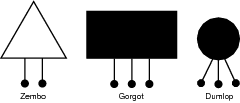Systematics, Taxonomy, and Classification: Linnaeus
Linnaeus
Bioterms
Taxonomy is the classification of organisms, both plant and animal, based on their structural characteristics and evolutionary history.
Aristotle is credited with creating the first classification system more than 2,000 years ago. He classified living things as plant or animal according to their appearance. This system was expanded later by the Romans to be more specific down to the individual organism types, such as a cow or elm tree. As more organisms were identified and classified, more words were needed to separate similar organisms, such as two types of dog. So new organisms were classified by using lengthy descriptors, which eventually became cumbersome to use as more organisms created the need for more words. Carolus Linnaeus, a Swedish naturalist, began the struggle to classify all living things by proposing a binomial, or two-name system. In this model, the genus is the first name, and the species is the second name, with the first letter of the genus name always capitalized. Therefore, each organism is sorted by a genus, species classification, such as Homo sapien for man. Linnaeus also proposed to expand the genus-species nomenclature to include larger units of likeness, for recognizing extended degrees of kinship. Today, the categories are still based on Linnaeus's work. For example, the taxonomy for humans is the following:
| Domain—Eukaryote | Order—Primate |
| Kingdom—Animal | Family—Hominidae |
| Phylum—Chordate | Genus—Homo |
| Subphyla—Vertebrate | Species—Sapien |
| Class—Mammal |
Moving from domain to species, the organisms are more closely related, such that organisms in the same species have a greater degree of kinship than organisms that are similar only at their family level. For instance, both cats and humans are in the class Mammalia, but their pathways separate at that point because cats are in the order Carnivora, whereas humans are Primates. However, a grizzly bear, a black bear, and a polar bear are more closely related because they are in the same family: Ursidae. Further, grizzly bears and black bears are more closely related to each other than to the polar bear because the grizzly and black bear are in the same genus: Ursus, but the polar bear is not. Systematics operates to identify relative kinship and evolutionary intersects among species.
Examine the following classification chart. Which pair of organisms are most closely related?
| 1 | 2 | 3 | ||
|---|---|---|---|---|
| Kingdom | Animal | Animal | Animal | |
| Phylum | Chordate | Chordate | Chordate | |
| Class | Mammal | Mammal | Mammal | |
| Order | Primate | Carnivore | Carnivore | |
| Family | Hominidae | Felidae | Felidae | |
| Genus | Homo | Panthera | Felis | |
| Species | Sapiens | Leo | Domesticus |
Organisms 2 and 3 are most closely related because they have the same family name. Organism 2 is a lion, organism 3 is a common housecat, and organism 1 is a human.
Binomial Classification
The binomial classification system proposed by Linnaeus allowed him and others to group organisms together based on common structures, functions, and resulting behaviors, which led to the science of taxonomy, or classification.

Often biologists use a taxonomic key, also known as a dichotomous key, to identify unknown organisms by their physical characteristics. Taxonomic keys work on a base-two premise: The organism either has the characteristic or does not. The resulting answer then directs the biologist to the next set of questions until all the characteristics have been accounted for and the organism is identified. The following Binomial classification illustration is a fictitious key that demonstrates the process.
Try using the following taxonomic key to identify which organism is a “dumlop.”
| Characteristic | Organism | |
|---|---|---|
| 1a. | It has two legs. | Zembo |
| 1b. | It has more than two legs. | Go to 2 |
| 2a. | It is shaded. | Go to 3 |
| 2b. | It is not shaded. | Go to 4 |
| 3a. | It has a round head. | Dumlop |
| 3b. | It does not have a round head. | Gorgot |
Backtracking from the dichotomous key, a dumlop is an organism that has more than two legs, is shaded, with a round head. Most dichotomous keys are quite lengthy, to account for all the features that a set of organisms may possess. The broadest keys begin at the kingdom level and proceed to the more specific genus and species levels.

Excerpted from The Complete Idiot's Guide to Biology © 2004 by Glen E. Moulton, Ed.D.. All rights reserved including the right of reproduction in whole or in part in any form. Used by arrangement with Alpha Books, a member of Penguin Group (USA) Inc.
To order this book direct from the publisher, visit the Penguin USA website or call 1-800-253-6476. You can also purchase this book at Amazon.com and Barnes & Noble.
